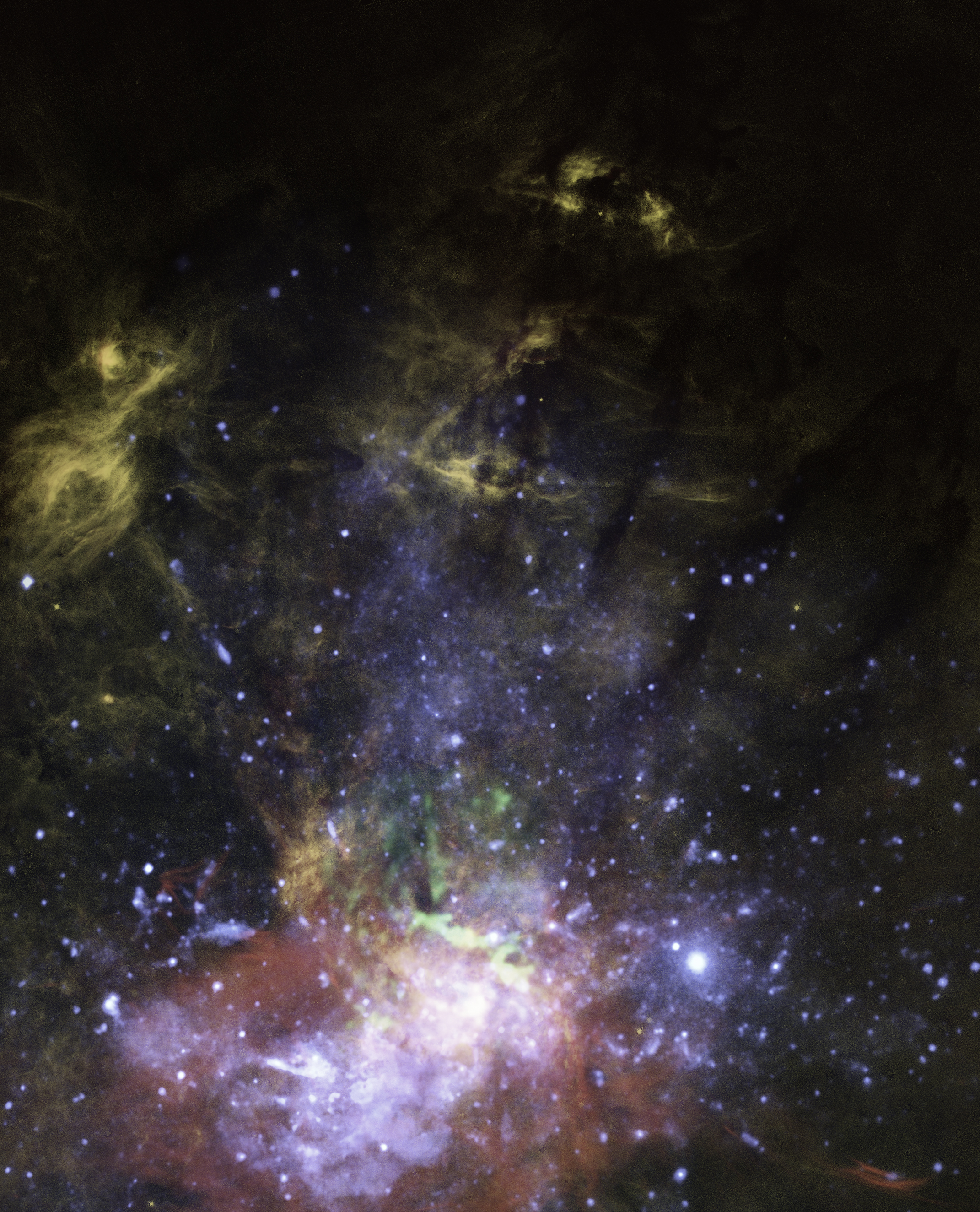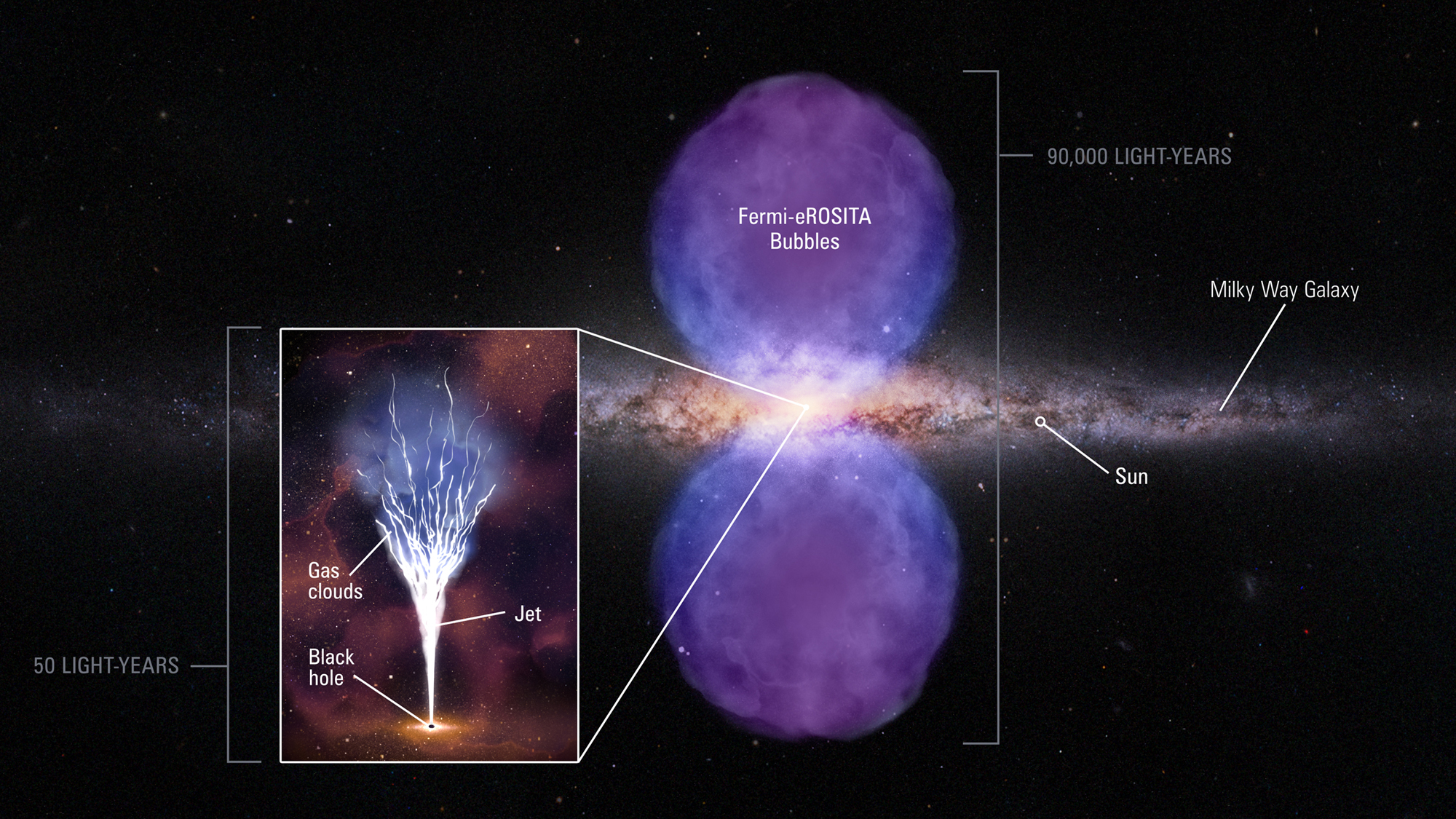The Milky Way's supermassive black hole burps 'mini-jets,' scientists find
The supermassive black hole at the center of our Milky Way galaxy periodically "burps" a "mini-jet" out into space.
The Milky Way's supermassive black hole, known as Sagittarius A* (Sgr A*), is over 4 million times more massive than our sun. Its strong gravitational pull draws nearby stars and gas clouds into its accretion disk. Some of this infalling material is then superheated and expelled from the black hole as narrow beams, also known as jets.
Remnants of this "blowtorch-like jet" date back several thousand years. However, NASA's Hubble Space Telescope hasn't been able to explicitly photograph the jet. Instead, observations from the space telescope reveal evidence that suggests a glowing cloud of hydrogen near the black hole was hit by an explosive outburst, according to a statement from the space agency.
Video: Milky Way's supermassive black hole has 'blowtorch-like' jet
Related: Black holes of the universe (images)

This explosive outburst is believed to be an outflowing jet of material that occasionally shoots into space as material like nearby gas clouds falls into the Milky Way's central black hole. As the jet travels away from the black hole, it collides with the hydrogen cloud and interacts with the gas in a way that creates multiple streams of expanding bubbles that extend out roughly 500 light-years into the Galactic halo, according to the statement.
"The streams percolate out of the Milky Way's dense gas disk," Alex Wagner, co-author of the study and a researcher from Tsukuba University in Japan, said in the statement. "The jet diverges from a pencil beam into tendrils, like that of an octopus."
Finding an elusive jet
Earlier research from 2013 using data from NASA's Chandra X-ray Observatory and the Jansky Very Large Array telescope in New Mexico revealed evidence of a southern jet near the black hole, which was shooting out into gas near the black hole, too.
Get the Space.com Newsletter
Breaking space news, the latest updates on rocket launches, skywatching events and more!
In this new study, using data from NASA's Hubble Space Telescope and the ALMA (Atacama Large Millimeter/Submillimeter Array) Observatory in Chile, researchers looked for traces of a northern counter-jet. While the ALMA observations showed a narrow linear feature extending 15 light-years into the molecular gas cloud from the black hole, Hubble infrared images capture a glowing, inflating bubble of hot gas that extends at least 35 light-years from the black hole, aligning with the narrow jet.
By piecing together evidence of the elusive jet, the researchers suggest that the black hole burps out "mini-jets" every time it consumes something massive, like a gas cloud. In turn, the interaction between the jet and surrounding hydrogen gas inflates the bubble. The researchers were able to recreate their findings using supercomputer models of simulated jet outflows, according to the statement.

Fermi gamma-ray bubbles
Hubble and other telescopes have previously found evidence that suggests the Milky Way's black hole had an outburst about 2-4 million years ago that created a massive pair of bubbles that glow above our galaxy, also known as Fermi gamma-ray bubbles.
"Our central black hole clearly surged in luminosity at least 1 millionfold in the last million years," Wagner said in the statement. "That sufficed for a jet to punch into the Galactic halo."
Similar evidence has been found in an active spiral galaxy, called NGC 1068, which lies 47 million light-years away. This galaxy also has a string of bubble features aligned along an outflow jet from its central black hole, according to the statement.
"A bow shock bubble at the top of the NGC 1068 outflow coincides with the scale of the Fermi bubble start in the Milky Way," Gerald Cecil, lead author of the study and a researcher from the University of North Carolina in Chapel Hill, said in the statement. "NGC 1068 may be showing us what the Milky Way was doing during its major power surge several million years ago."
In the new study, Hubble data was used to better understand the expansion velocity and composition of the Milky Way's Fermi gamma-ray bubbles. Hubble telescope images revealed the Milky Way's black hole outburst was so powerful that it illuminated a gaseous structure, called the Magellanic Stream, 200,000 light-years from the galactic center. The blast was so powerful that gas is still glowing from that event today, according to the statement.
While the Milky Way's central black hole is currently powered down, the residual "mini-jet" is close enough to reignite quickly should the black hole power up again, the researchers said in the statement.
"The black hole need only increase its luminosity by a hundredfold over that time to refill the jet channel with emitting particles," Cecil said in the statement. "It would be cool to see how far the jet gets in that outburst. To reach into the Fermi gamma-ray bubbles would require that the jet sustain for hundreds of thousands of years because those bubbles are each 50,000 light years across!"
These findings were published Dec. 6 in The Astrophysical Journal.
Follow Samantha Mathewson @Sam_Ashley13. Follow us on Twitter @Spacedotcom and on Facebook.
Join our Space Forums to keep talking space on the latest missions, night sky and more! And if you have a news tip, correction or comment, let us know at: community@space.com.

Samantha Mathewson joined Space.com as an intern in the summer of 2016. She received a B.A. in Journalism and Environmental Science at the University of New Haven, in Connecticut. Previously, her work has been published in Nature World News. When not writing or reading about science, Samantha enjoys traveling to new places and taking photos! You can follow her on Twitter @Sam_Ashley13.









